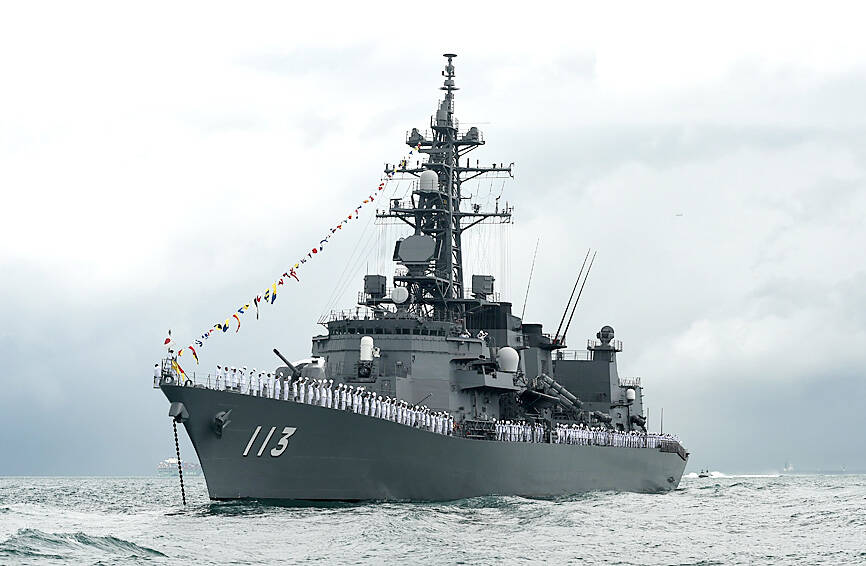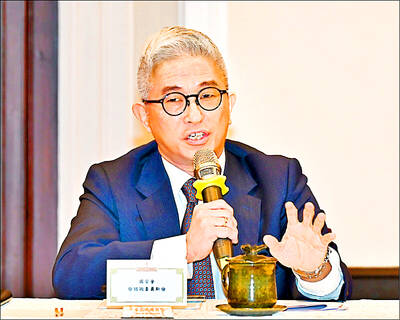The Philippine and Japanese navies yesterday held their first joint exercise in the South China Sea, as the two US allies boost security ties in the face of China’s growing pressure.
The drills followed the signing less than a month ago of an agreement between Manila and Tokyo to allow the deployment of troops on each other’s territory.
The Japanese destroyer JS Sazanami and the Philippine guided missile frigate BRP Jose Rizal took part in the two nations’ first bilateral “Maritime Cooperative Activity,” the Philippine military said in a statement.

Photo: AFP
“This activity was part of the ongoing efforts to strengthen regional and international cooperation towards realizing a free and open Indo-Pacific,” the statement said.
The two vessels held a communications exercise and undertook tactical maneuvers in the West Philippine Sea, Manila’s name for parts of the South China Sea that are closest to its coast.
These “enhanced the tactical capabilities of the Philippine Navy and the Japan Maritime Self-Defense Force and reinforced the strong ties and mutual commitment to maintaining peace and stability in the region,” the statement added.
A similar exercise was held two days earlier, also in South China Sea waters close to the Philippines, between the Philippine navy patrol ship BRP Ramon Alcaraz and the US Navy’s littoral combat ship USS Mobile.
The Philippines and Japan are longtime allies of the US, which has been strengthening its alliances from Canberra to Tokyo to counter China’s growing military might and influence in the region.
The deepening of Philippine-Japanese security ties comes as China’s saber rattling toward Taiwan and over the South China Sea fuels fears of a potential conflict that could drag in the US.
There have been escalating confrontations at sea between Chinese and Philippine vessels as Beijing steps up its efforts to push its claims to nearly all of the strategic South China Sea.

A car bomb killed a senior Russian general in southern Moscow yesterday morning, the latest high-profile army figure to be blown up in a blast that came just hours after Russian and Ukrainian delegates held separate talks in Miami on a plan to end the war. Kyiv has not commented on the incident, but Russian investigators said they were probing whether the blast was “linked” to “Ukrainian special forces.” The attack was similar to other assassinations of generals and pro-war figures that have either been claimed, or are widely believed to have been orchestrated, by Ukraine. Russian Lieutenant General Fanil Sarvarov, 56, head

SAFETY FIRST: Double the number of police were deployed at the Taipei Marathon, while other cities released plans to bolster public event safety Authorities across Taiwan have stepped up security measures ahead of Christmas and New Year events, following a knife and smoke bomb attack in Taipei on Friday that left four people dead and 11 injured. In a bid to prevent potential copycat incidents, police deployments have been expanded for large gatherings, transport hubs, and other crowded public spaces, according to official statements from police and city authorities. Taipei Mayor Chiang Wan-an (蔣萬安) said the city has “comprehensively raised security readiness” in crowded areas, increased police deployments with armed officers, and intensified patrols during weekends and nighttime hours. For large-scale events, security checkpoints and explosives

‘POLITICAL GAME’: DPP lawmakers said the motion would not meet the legislative threshold needed, and accused the KMT and the TPP of trivializing the Constitution The Legislative Yuan yesterday approved a motion to initiate impeachment proceedings against President William Lai (賴清德), saying he had undermined Taiwan’s constitutional order and democracy. The motion was approved 61-50 by lawmakers from the main opposition Chinese Nationalist Party (KMT) and the smaller Taiwan People’s Party (TPP), who together hold a legislative majority. Under the motion, a roll call vote for impeachment would be held on May 19 next year, after various hearings are held and Lai is given the chance to defend himself. The move came after Lai on Monday last week did not promulgate an amendment passed by the legislature that

PENTAGON ASSESSMENT: A US report said that even as China and Russia deepen their partnership, cooperation is hindered by a ‘mutual distrust’ of each other The Chinese People’s Liberation Army (PLA) as of October had doubled the number of ships and airplanes deployed around Taiwan compared with the previous two years, Vice Minister of National Defense Hsu Szu-chien (徐斯儉) said yesterday, a day after the opposition-controlled legislature voted against reviewing the government’s general budget for next year, including a NT$1.25 trillion (US$39.71 billion) special defense spending bill. The legislature’s vote against the Ministry of National Defense’s spending plans was regrettable, as the budget was designed to respond to the developing Chinese military threat, Hsu said on the sidelines of a legislative meeting on the general budget. Defense